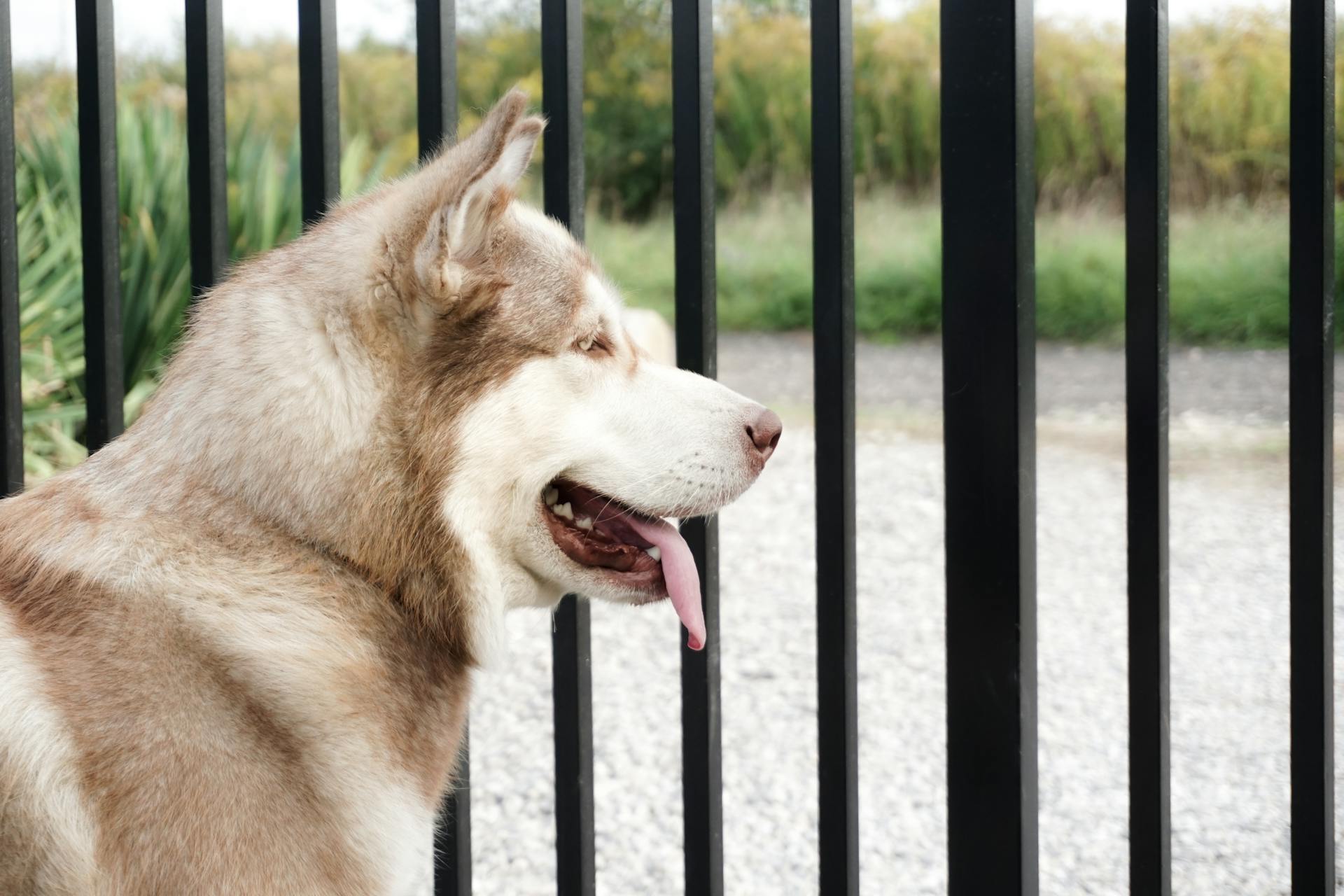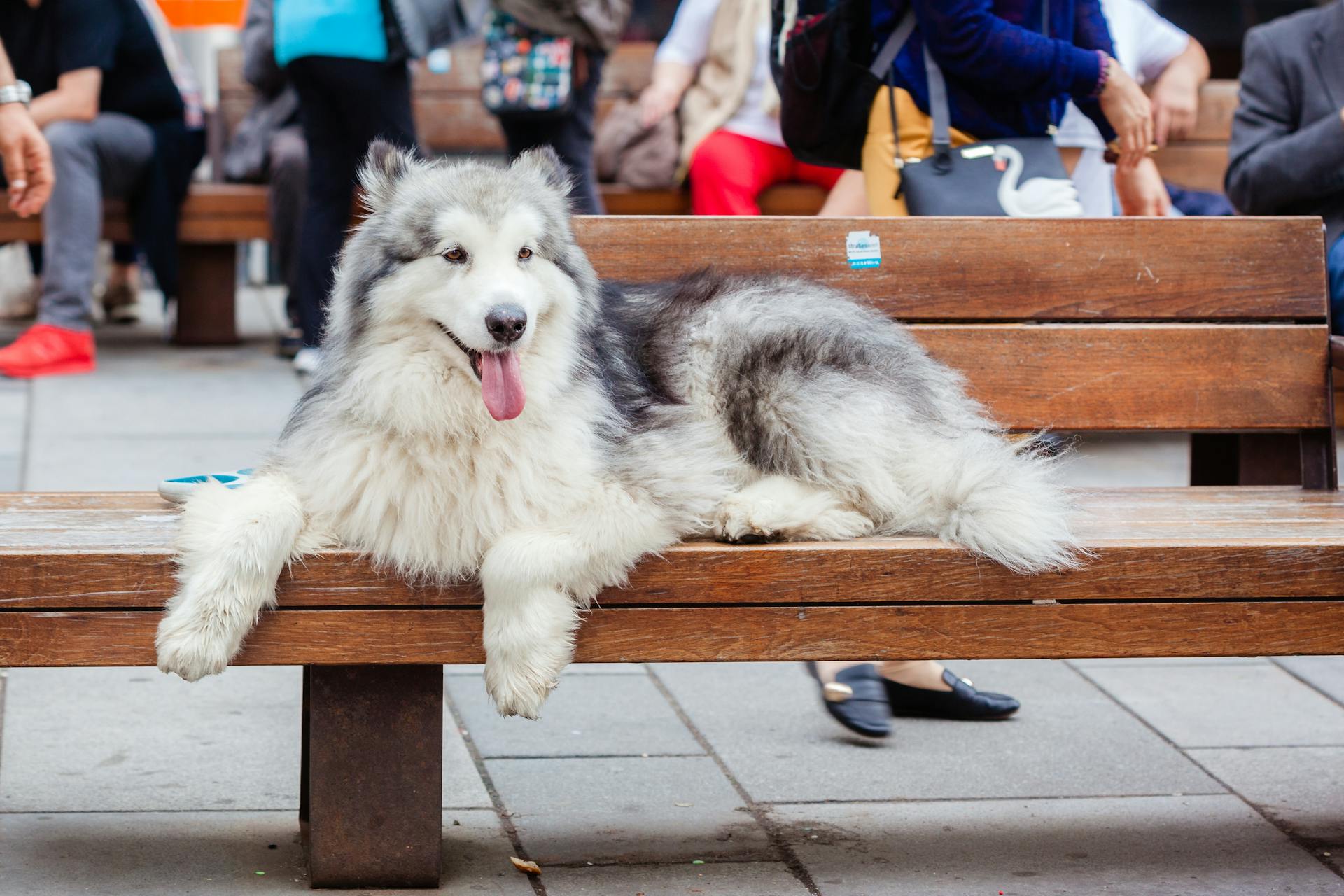
Training an Alaskan Malamute requires patience and consistency, as these dogs are naturally strong-willed and independent.
Establishing a routine is crucial, as Alaskan Malamutes thrive on structure and predictability. They need clear boundaries and consistent rules to feel secure and confident.
Positive reinforcement techniques work best for Alaskan Malamutes, as they are highly motivated by rewards and praise. This breed responds well to treats, affection, and playtime when good behavior is exhibited.
Socialization is also key, as Alaskan Malamutes can be wary of strangers and may develop protective instincts if not properly socialized from an early age.
For your interest: Are Alaskan Malamutes Good Guard Dogs
Getting Started
To establish a strong bond with your Alaskan Malamute, spend time playing with them and engaging in activities they enjoy, providing positive reinforcement through praise and treats. Building trust and a strong connection is crucial for a positive response to commands.
Active training is vital for Malamutes, as they tend to do as they please without it. Consider investing in basic training books and attending classes.
Broaden your view: Positive Dog Training
Malamutes are smart, requiring a strong relationship with their owner. They see training as a game, not obedience, and their motivation comes from respect, praise, food, comfort, and social attention.
First-time owners may find it difficult to train an Alaskan Malamute due to their independent nature. However, with patience, consistency, and positive reinforcement, they can be trained.
Training Fundamentals
Training your Alaskan Malamute starts at around eight weeks old. Begin by establishing a positive relationship with your furry friend through rewards and praise.
Positive reinforcement is key, so avoid punishment and yelling, as this can create a negative association with training. Reward good behavior with treats, praise, or play.
Start teaching basic cues like 'come', 'sit', and 'down' in a quiet indoor area to minimize distractions. Gradually increase the distance while keeping the exercise fun and rewarding.
For loose-leash walking, use a consistent cue word and reward your puppy for walking next to your leg. Use treats to encourage them to follow and redirect them when they pull.
Teaching 'sit' and 'down' commands is best done using the capturing or luring methods. Reward your puppy when they naturally perform the behavior or use a treat to guide them into position.
Check this out: Training a Dog to Lay down
Behavior and Training
Establishing a strong bond and clear communication with your Alaskan Malamute is crucial for behavioral training and temperament management. This breed requires a positive approach and a solid understanding of their unique temperament.
Consistency and reinforcement of expectations are key in training Malamutes. Active training is essential to prevent them from doing as they please, and negative training methods should be avoided. Malamutes respond well to positive reinforcement, such as praise, food, comfort, and social attention.
Here are some common behavioral issues that may arise in Malamutes:
- Excessive Chewing: Malamutes love to chew. Provide plenty of chew toys and discourage chewing on inappropriate items.
- Barking and Howling: Teach your pup the ‘quiet’ command early on and reward silence.
- Digging: Designate an area in your yard where it’s permissible to dig.
- Jumping up: Teach your Malamute pup to greet you and others politely, with all four paws on the ground.
- Pulling on the leash: Start leash training early to discourage this behavior.
Addressing Behavior Issues
Addressing behavior issues in your Alaskan Malamute requires patience, consistency, and positive reinforcement techniques. The breed is intelligent and independent, responding well to praise, comfort, and social attention.
Common behavior issues in Malamutes include stealing food, digging, and jumping on guests. These behaviors should be addressed early to prevent them from becoming bad habits. Repetitive drills bore them, and they require motivation to cooperate.
For your interest: Alaskan Malamute Behavior
To address these issues, establish clear boundaries and expectations, and use positive reinforcement techniques such as rewards and praise. Your voice and gestures are crucial in conveying praise or correction, and reinforcing your dominance through submissive gestures like handshaking can strengthen your authority.
Some common training challenges include:
- Stealing food
- Digging
- Jumping on guests
- Growling or nipping tendencies
These challenges require consistent attention and remedial work. It's best to start training early to prevent the formation of bad habits. By being patient and persistent, you can shape your Alaskan Malamute into a well-behaved and respectful companion.
Remember, every dog is unique, and the key to success is consistent practice and positive reinforcement. Don't be afraid to seek help from a professional trainer if you're struggling with behavior issues.
Dogs and Separation Anxiety
Alaskan Malamutes are known to form a strong bond with their owners, but this can sometimes lead to separation anxiety when they're left alone. Gradually increasing the time you spend apart is a good start.
Providing mental stimulation through toys or puzzles can help alleviate boredom and separation anxiety in your dog. Rewarding calm behavior when you leave and return is also essential.
You can try leaving for short periods initially and gradually increasing the time you're away. This will help your dog get used to being alone.
Exercise and Stimulation
Alaskan Malamutes are highly energetic dogs that require a significant amount of exercise to stay healthy and happy. They need at least 60 to 90 minutes of vigorous exercise every day, which can include activities like hiking, running, swimming, and playing fetch.
They also excel in dog sports such as agility, weight pulling, and obedience. A daily walk is not enough to meet their exercise needs, so it's essential to provide them with a large yard or access to open spaces where they can run and play.
To prevent boredom and destructive behavior, Alaskan Malamutes require mental stimulation in addition to physical exercise. They are intelligent dogs that enjoy learning new things and solving puzzles, making them perfect for interactive toys like puzzle feeders and chew toys.
Digging
Digging is a natural behavior for Alaskan Malamutes, especially if they're feeling bored or have excess energy to burn off.
Providing them with a designated digging area, such as a sandbox or a specific spot in the yard, can redirect this behavior.
Regular exercise can help alleviate excessive digging, but it's not a substitute for mental stimulation.
Alaskan Malamutes need mental stimulation to stay happy and healthy, and redirecting their digging behavior is a good place to start.
Encourage your Malamute to dig in the designated area by burying toys or treats and rewarding them for digging in the right spot.
By doing so, you'll be teaching your Malamute that digging is a fun and acceptable behavior, as long as it's done in the right place.
Physical and Mental Stimulation
Alaskan Malamutes are highly energetic dogs that require a significant amount of exercise to stay healthy and happy. They need at least 60 to 90 minutes of vigorous exercise every day, which can include activities like hiking, running, swimming, and playing fetch.
A daily walk is not enough to meet their exercise needs, so it's essential to provide them with more strenuous activities. They excel in dog sports such as agility, weight pulling, and obedience, which can be a great way to challenge them physically and mentally.
In addition to physical exercise, Alaskan Malamutes require mental stimulation to prevent boredom and destructive behavior. They are intelligent dogs that enjoy learning new things and solving puzzles, so it's crucial to provide them with activities that challenge their minds.
Some great ways to provide mental stimulation include interactive toys like puzzle feeders and chew toys, as well as activities like hide-and-seek, scent work, and trick training. These activities can help keep your Alaskan Malamute engaged and prevent boredom.
Here are some recommended daily activities to provide physical and mental stimulation for your Alaskan Malamute:
- Brisk walks or jogging
- Hiking or trail running
- Playing fetch or tug-of-war
- Interactive games like agility or obedience training
- Puzzle toys and chew toys
- Hide-and-seek or scent work
- Trick training or obedience competitions
Remember, every dog is different, so it's essential to tailor your activities to your Alaskan Malamute's individual needs and preferences. With the right combination of physical and mental stimulation, you can help your Alaskan Malamute thrive and live a happy and healthy life.
Housebreaking and Crate Training
Establishing a consistent routine for bathroom breaks is crucial when housebreaking your Alaskan Malamute. Take them outside regularly, especially after meals, playtime, and waking up from a nap.
Choose a specific spot in your yard as the designated bathroom area and encourage your dog to eliminate there with verbal cues. Immediately reward them with praise and treats after they finish.
Accidents may happen during the housebreaking process, but it's essential to remain patient and avoid punishment, as this can hinder progress. Punishment can instill fear and create a negative association with training.
Introduce the crate to your Alaskan Malamute gradually, allowing them to explore it at their own pace. Make the crate a positive and inviting space by placing comfortable bedding and a few toys inside.
Reward your dog with treats and praise when they show interest in the crate, and gradually increase the duration of time spent in the crate. Always associate the crate with positive experiences and rewards.
Consistency and patience are key when housebreaking your Alaskan Malamute. Establish a routine and stick to it to ensure a clean and comfortable living environment for both you and your dog.
Suggestion: When Is the Best Time to Breed a Female Dog
Working with Trainers
Working with trainers can be a game-changer for Alaskan Malamute owners. You can find professional trainers who specialize in positive reinforcement training methods and have experience working with Alaskan Malamutes or similar breeds.
To find the right trainer, look for recommendations from trusted sources, online reviews, or local breed-specific clubs. Trainers with a reputation for patience, expertise, and a friendly approach are ideal.
Collaboration with your trainer is essential for a successful training experience. Communicate your expectations, concerns, and goals clearly to the trainer, and actively participate in training sessions.
Professional trainers can provide expert guidance and support throughout your training journey. They can help you address specific training challenges and tailor their approach to the needs of your Alaskan Malamute.
Consider enrolling your Alaskan Malamute in a professional training school, such as PetSmart Training, The Canine Coach, or Off Leash K9 Training. These schools offer a wide range of classes, from basic obedience to advanced agility.
Professional trainers can help you overcome training obstacles and ensure a smoother and more effective training process. They can also provide valuable insights, techniques, and strategies to help you achieve your training goals.
Here are some popular training schools that specialize in Alaskan Malamute training:
- PetSmart Training: Offers group classes for puppies and adult dogs, as well as private sessions.
- The Canine Coach: Provides personalized training programs for dogs of all ages and skill levels.
- Off Leash K9 Training: Specializes in obedience training and behavioral modification.
Working with a professional trainer can be a great way to ensure that you and your Alaskan Malamute are getting the most out of your training experience.
Advanced Training
Establishing a solid foundation in basic obedience is essential for advanced training, so start with the core commands of 'come', 'sit', and 'heel'.
These commands form the basis of all subsequent training, and it's crucial to master them before moving on to more advanced routines.
Alaskan Malamutes are natural work dogs, with a long history of pulling sleds and carrying heavy loads in the harsh Alaskan climate.
Weight pulling and sledding are two activities that can provide a fantastic outlet for their energy and strength.
Training for weight pulling involves starting with low weights and gradually increasing as your Malamute becomes more comfortable.
Sledding training requires a strong bond between owner and dog, and starts with basic commands like 'go', 'stop', 'left', and 'right'.
Force-breaking teaches your Malamute to hold onto objects and not let go until commanded.
Table training helps maintain control and stability during training sessions, providing a safe and effective way to train your dog in new commands and behaviors.
Collar-conditioning reinforces trained actions and helps your dog associate the command with the action, particularly useful for field work and yard work.
To excel in advanced activities, it's crucial to properly train your Alaskan Malamute, starting with a solid foundation in basic obedience.
A high-fat and high-protein diet is necessary for training your Malamute for roles like sled dogs and weight pullers, especially in cold weather.
Always ensure they have adequate water to prevent dehydration during training.
Training your Malamute for weight-pulling competitions can start at six months old, but most competitions require dogs to be a year old.
Additional reading: Crate Training a Dog during the Day
Here's a quick guide to some of the activities your Alaskan Malamute can excel in:
Experienced dog handlers may find the Alaskan Malamute easier to train compared to first-time owners, as they have the knowledge and skills to handle the breed's strong personality.
Health and Well-being
Hip dysplasia can limit your Alaskan Malamute's mobility, making physical training tough. Regular vet check-ups can help catch this issue early.
Eye problems can affect their ability to follow visual commands. This can make training more challenging if your Malamute is struggling to see.
Thyroid disorders can cause fatigue, limiting their energy for training. It's essential to keep an eye out for signs of fatigue and adjust your training schedule accordingly.
Socialization
Socialization is a critical aspect of Alaskan Malamute training, and it's essential to start early. You can begin by introducing your puppy to different environments, such as taking them on short car trips, starting with secure seating and suitable weather.
It's crucial to never leave a young puppy alone in the car and always have engaging toys to keep them occupied. When parking, choose safe, visible areas to avoid theft or harm.
Socialization can be expanded by visiting friends' homes and introducing your Malamute to other pets. You can also take them on errands to pet-friendly places like Tractor Supply Co., pet stores, and plant nurseries.
However, keep visits short and watch for signs of restlessness. Always let your puppy potty before leaving home and again before entering a place. Be prepared with clean-up materials in case of accidents.
To provide your Malamute with positive early experiences, shape their behavior positively by exploring different types of businesses, such as plant nurseries and bookstores.
Here are some popular resources for training clubs and community groups:
- The American Kennel Club: Offers a variety of training resources, including classes, events, and online resources.
- The United Kennel Club: Provides a range of training programs and competitions for dogs and their owners.
- Meetup Groups: Offers a variety of local groups focused on dog training and socialization.
Early socialization is vital for Alaskan Malamutes, and it's recommended to enroll them in puppy classes or take them to dog parks to interact with other dogs. This helps build their confidence and trust in their owners.
Consistent, positive reinforcement is key to helping your Malamute understand and follow instructions, especially when it comes to socialization and obedience training. This begins with basic commands and gradually incorporates more complex tasks.
Resources
Training an Alaskan Malamute requires patience and consistency. Training an Alaskan Malamute can be challenging due to their independent nature.
Positive reinforcement is a key approach to Alaskan Malamute training. This involves rewarding good behavior with treats and praise.
There are various training resources available to help owners and their dogs succeed. The most popular options include online courses, training classes, and private coaching.
Online courses can be a convenient and flexible way to learn training techniques. Many online courses offer video lessons and interactive exercises.
Training classes provide socialization opportunities for Alaskan Malamutes and their owners. This can help build confidence and strengthen the bond between dog and owner.
Private coaching offers personalized guidance and support for owners and their dogs. This can be especially helpful for owners who need extra support or have specific training goals.
If this caught your attention, see: Shiba Inu Owner
Frequently Asked Questions
What age do Malamutes calm down?
Malamutes typically calm down and mature between 2-3 years of age, but some may take longer to reach their full calmness. With proper training and socialization, they can become more relaxed and laid-back companions.
Sources
- https://www.malamuterescue.com/alphatraining.html
- https://www.malamutehq.com/alaskan-malamute-training/
- https://iheartdogs.com/11-secrets-to-make-your-alaskan-malamute-come-when-called/
- https://blog.tryfi.com/are-alaskan-malamutes-easy-to-train/
- https://pets.joinfluffy.com/pet-universe/post/dog/training/alaskan-malamute-training
- https://malamutepal.com/tips-for-training-alaskan-malamutes/
Featured Images: pexels.com


